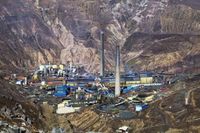Tragedy struck at El Teniente, Chile's sprawling copper mine, as rescue teams continue their desperate efforts to save five miners trapped deep underground following a devastating collapse last Thursday. The death toll has now risen to two, after human remains were discovered during the painstaking search through the debris-strewn tunnels, according to Chile's state-owned mining company, Codelco.
The collapse occurred amid a seismic event recorded by the National Seismological Center of the University of Chile, which registered a magnitude 4.3 earthquake near the mine on July 31, 2025. This quake severely damaged a shaft at El Teniente, forcing an immediate halt to mining operations and leaving nine others injured alongside the five trapped workers.
El Teniente, nestled in Chile's O'Higgins region about 100 kilometers south of Santiago, holds the title of the world's largest underground copper mine. It boasts an extensive network of over 4,500 kilometers of tunnels and produced 356,000 tonnes of copper last year—accounting for nearly 7% of Chile's total output. Chile itself dominates global copper production, supplying nearly a quarter of the world's copper, with about 5.3 million tonnes produced in 2024.
Despite the mine’s long history dating back to the early 1900s, this collapse is one of the most significant seismic events El Teniente has faced in decades. Andrés Music, the mine’s general manager, described it as “one of the biggest events, if not the biggest, that the El Teniente deposit has experienced in decades.” The tremor’s impact was so severe that it caused the partial collapse, trapping workers at a depth exceeding 900 meters.
Rescue efforts have been intense and perilous. Over 100 personnel, including some of the very rescuers who famously surfaced 33 trapped miners in the Atacama Desert back in 2010, have been mobilized to clear debris and reach the men. However, progress has been slow; rescuers must remove approximately 20 meters (65 feet) of rubble in the tunnel to reach the trapped miners, but by Friday only four meters had been cleared.
Codelco’s CEO Rubén Alvarado stressed the urgency: “The first 48 hours are fundamental” in locating survivors. Yet, as hours tick by, the situation grows more precarious, especially with the confirmation of a second fatality. Andrés Music announced on August 2 that human remains had been found, a grim discovery that “hits hard for the families of our colleagues and for our entire mining community.” He added, “This discovery fills us with sadness, but it also shows us that we are in the right place, that the strategy we followed led us to them.”
President Gabriel Boric has been closely involved since the incident, pledging the government's full support in the rescue operation. On August 1, via the social media platform X, he vowed to do “everything in (our) power” to find the missing miners and instructed Minister of Mining Aurora Williams to coordinate all necessary actions on the ground. At a press conference on August 2, Boric extended his condolences to the family of Paulo Marín Tapia, one of the miners who lost his life in the collapse, and affirmed ongoing contact with the relatives of those still trapped.
The emotional toll on the mining community is palpable. Edgar Rodrigo Quesada, a miner and former union leader, shared with CNN the anxiety gripping the workers and families. He explained that while there is a shelter within the tunnel designed for emergencies, it is located far from where the collapse happened. “I just pray to God that my coworkers are okay,” Quesada said. “Honestly, the shelter is very far from the collapse site.” Another miner, Abelardo Céspedes, expressed cautious optimism: “We have hope that they will be rescued alive. We trust a lot in God, we are very faithful, and maybe God will work a miracle and bring them out alive. That’s the hope we all have.”
Authorities have launched investigations into the cause of the accident. The Chilean prosecutor’s office is actively probing the circumstances surrounding the collapse, while Codelco is conducting its own internal inquiry. Andrés Music was keen to clarify that the accident was not caused by the use of explosives, emphasizing, “We are making every effort to rescue these workers.”
This tragedy casts a shadow over Codelco’s production prospects, coming just days after the company celebrated the U.S. government's decision to exempt its copper from hefty tariffs. The accident raises questions about the company’s ability to meet growing global demand amid such setbacks. The scenes unfolding in the Andes mountains south of Santiago have drawn comparisons to the dramatic rescue of 33 miners trapped for over two months in 2010, an event that captured worldwide attention and highlighted Chile’s mining resilience.
Chile’s mining industry is widely regarded as one of the safest globally, boasting a remarkably low death rate of 0.02 percent last year, according to the National Geology and Mining Service of Chile. Yet, the country’s location along the seismically volatile “Ring of Fire” means that such natural disasters remain a constant threat.
As search teams press on, weighing the risks of further collapse against the desperate need to reach the trapped miners, the nation watches and waits. The human drama unfolding at El Teniente is a stark reminder of the dangers inherent in mining, the fragility of life underground, and the enduring spirit of those who risk everything to bring colleagues home.



